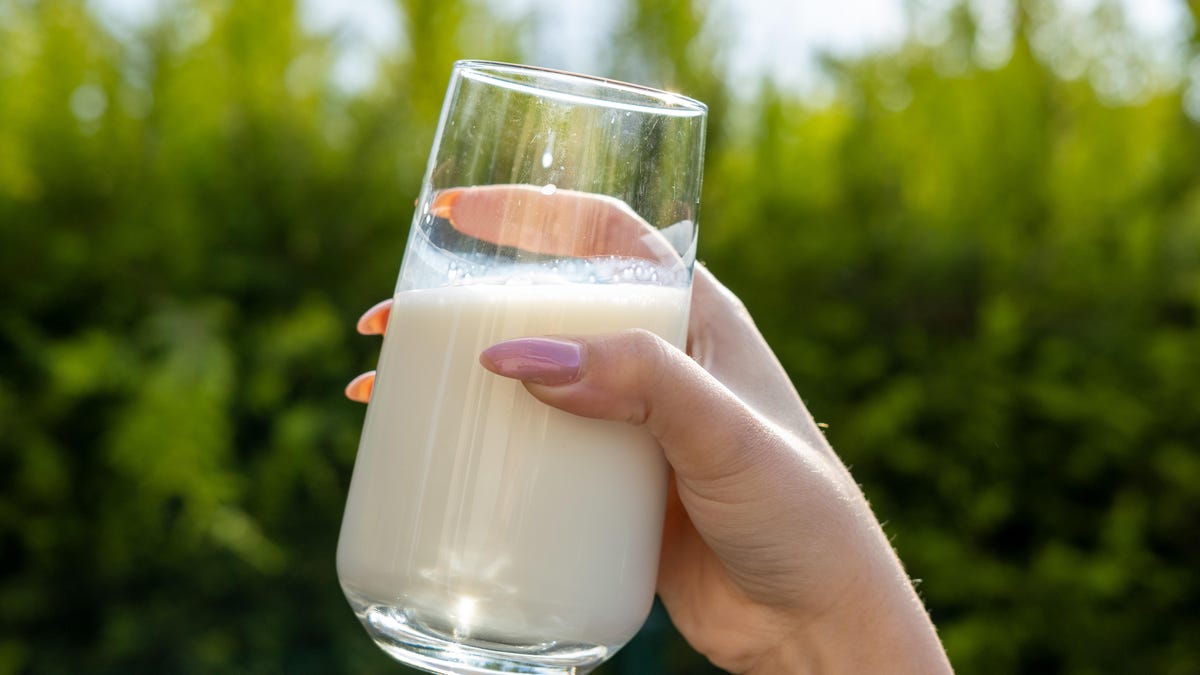More Bird Flu Found in Raw Milk: What You Need to Know to Stay Safe

The raw milk recall in California grew bigger this week, as state officials discovered more traces of the bird flu virus in “multiple” lots of raw milk produced by Raw Farm. The farm had previously recalled two lots of raw milk — one on Nov. 24 and another on Nov. 27.
Products in the recall now include all Raw Farm milk and cream produced between Nov. 9 and Nov. 27, 2024. The California Department of Public Health has quarantined Raw Farm and warns against “consuming any Raw Farm products for human consumption including raw milk, cream, cheese and kefir, as well as raw milk pet food topper and pet food kefir marketed to pet owners.”
No illnesses from consuming the raw milk batch have been reported, and state health officials say pasteurized milk remains safe to drink. Health officials have always said that raw milk carries some health risks, but warnings around raw milk consumption have been increased during the ongoing bird flu outbreak, which has caused some sporadic human cases in the US, mostly in people with direct contact with sick animals. Two cases, including one in a California child, have unknown exposure sources, according to the US Centers for Disease Control and Prevention. No person-to-person spread has been detected.
This is also not the first time the virus that causes bird flu, H5N1, has been found in grocery store milk. Earlier this year, fragments of the virus were found in roughly one in five pasteurized milk samples across the US, though additional genetic testing of the samples didn’t turn up an activated or infectious virus. That’s what experts have said would be the case, since pasteurization is expected to kill or inactivate bird flu virus, as it does other potentially harmful bacteria and viruses.
The FDA has said that the milk supply is safe; pasteurization is a requirement for commercial milk, making up the vast majority of milk found on store shelves — though not all, depending on local laws around raw milk sales. California, for example, allows retail sale of raw milk; according to the state’s post Sunday, health officials there have been regularly testing raw milk.
But outside what the FDA refers to as the “commercial” milk supply, there’s an ongoing trend of consumers choosing raw milk. While people who grew up on farms or around cattle might have had unpasteurized milk for dinner, raw milk has found a new audience in people in search of a food they feel is more natural or holistic or even part of a greater wellness or political trend.
Here’s what to know about pasteurization in milk and how to consider the raw milk wellness trend in bird flu times.
What is pasteurization? Will it kill bird flu?
Pasteurization is a heating process invented in the 1860s by French chemist Louis Pasteur and has been used widely since as a means to kill harmful bacteria and pathogens that can sometimes cause serious illness. These include bacteria that cause illness like E. coli, Listeria and Salmonella, and other pathogens.
Pasteurization is also expected to kill or inactivate the virus that causes bird flu, which is why health officials continue to say there’s no risk to pasteurized dairy products or the commercial milk supply.
Some dairy products may be ultrapasteurized, which is when milk is heated more quickly than typical pasteurization (a couple of seconds) at a higher temperature and then rapidly cooled down. This extends its shelf life.
Pasteurized dairy products can be organic or nonorganic. Whether you can buy or sell raw, unpasteurized milk depends on the laws in your state. In California, for example, you can buy raw milk from stores, although it has to be properly labeled with a warning stating it’s unpasteurized.
Jenna Guthmiller, an immunologist, influenza researcher and assistant professor in the Department of Immunology and Microbiology at the University of Colorado, told CNET this spring that if someone were to drink milk contaminated with H5N1, it doesn’t necessarily mean they would be infected. Influenza viruses are unstable outside the body, she explained, and milk “bypasses the normal process by which we get infected” with flu.
Dr. Amesh Adalja, an infectious disease specialist and senior scholar at the Johns Hopkins Center for Health Security, said in an email earlier this year that finding bird flu virus material in pasteurized milk doesn’t change the public health risk assessment for the commercial milk supply.
“Pasteurization is a process that would destroy the viability of pathogens — it’s not a process that eliminates their genetic material,” he said.
Adalja previously noted it’s “unclear” whether there would be a live virus in unpasteurized milk or if it could infect humans by their drinking it, he explained. Influenza viruses aren’t spread to humans via ingestion. But on raw milk, he added, “there are many reasons not to drink it to begin with.”
Risks of drinking unpasteurized milk
Drinking or accidentally inhaling raw milk that contains bird flu virus may lead to illness, health officials from California said this week while announcing the recalled lot. Unwashed hands with contaminated raw milk touching your eyes, nose or mouth may also lead to infection.
The CDC issued a separate reminder this summer over the increased risks of drinking raw milk following detection of the H5N1 virus in raw milk. However, the experts I spoke with for this story before it was first published earlier this spring essentially said, in general, influenza is difficult to spread to people through eating or drinking. However, the University of Minnesota Center for Infectious Disease Research & Policy reported this week that while the level of risk is currently unknown, unpublished studies in mice suggest there is a risk pathway.
There’s also the existing health risks of raw milk, which isn’t part of what the FDA refers to as the “commercial” milk supply.
“In my opinion, there’s a concern with raw milk acquisitions which can become part of the food system, and people secure that milk outside of going to the grocery store,” Meg Schaeffer, an infectious disease epidemiologist and National Public Health adviser at the analytics firm SAS, told CNET this spring.
“Yes, we have enzymes in our body that can kill the virus,” Schaeffer said. “It’s not a likely pathway to infection, but it’s not impossible.”
In general, drinking raw milk has health risks. In addition to what Guthmiller called “old timey” bacteria that used to be a problem back in the day before processes like pasteurization cleaned up the food supply, unpasteurized or raw milk can expose people to serious illnesses like E. coli and listeria. While it may cause only temporary or milder illness in most people, people with weakened immune systems, older adults, those who are pregnant and very young children are especially at risk of serious health effects from drinking unpasteurized milk.
The risk is especially high in children, according to Schaeffer, who are vulnerable to severe illness. In serious cases, health effects from drinking raw milk that’s been contaminated can lead to kidney failure.
Schaeffer also pushed back on claims that diseases that once were a big problem in countries like the US, like tuberculosis, are no longer an issue. That’s true about tuberculosis, she said, but we also have effective treatment for it. That’s not the case, she said, for some types of illness that children can get from unpasteurized milk.
“The diseases, if anything, are even stronger — antibiotic resistant,” Schaeffer said. She added that some bacteria that may be in raw milk may go undetected by farmers because they don’t cause illness in cows but do in people.
While buying raw milk from a farm you know sets higher safety standards and practices “good hygiene” during milking can reduce the risk of contaminated raw milk, it won’t eliminate it, according to the CDC.
Why people drink raw milk
Proponents of raw or unpasteurized milk prefer it for different reasons, including its creamier texture and taste or anecdotal reports that it’s easier on digestion or more nutritious.
You can’t argue with someone’s taste or texture preferences when it comes to food. In terms of the nutritional or health benefits of raw milk compared with unpasteurized milk, research seems to have pushed back on or debunked the majority of claims. The FDA, for example, says that raw milk isn’t a cure or antidote for lactose intolerance. The agency also claims on the same information page that people are misusing the results of a study from 2007 that was on farm milk consumption, not raw milk consumption.
In an analysis of the risks versus benefits of raw milk research, Healthline reported that any small antimicrobial benefit from raw milk would be neutralized when it’s refrigerated. It also reported, based on the results of a systematic review, that minor nutrient losses of water-soluble vitamins, including some B vitamins, are already low in milk generally.
“Multiple studies have shown that pasteurization does not significantly affect the nutritional quality of milk,” the Centers for Disease Control and Prevention concludes. “Scientists do not have any evidence that shows a nutritional benefit from drinking raw milk.”
As someone who grew up on a dairy farm, Guthmiller used to drink unpasteurized milk herself — she gets it. When it comes to consuming raw milk, she said, “the risks certainly outweigh the pros.”
“We’re getting to a point with pasteurization where it looks like real milk,” Guthmiller said. In terms of nutritional quality, “you really do not affect the contents of the milk” by pasteurizing it, she said, because it’s done so quickly.
If you’re looking for foods with proven gut-health properties, look at adding foods like kimchi, pickled vegetables, sourdough, apple cider vinegar and buttermilk.
The importance of ‘risk vs. benefits’ in health and wellness
I’d be a hypocrite if I wrote this without noting I’ve experimented with a few things in the wellness realm that were either not recommended by a health body like the CDC, or “rooted in science,” as they say. Sometimes, I like wading into wellness waters tipped toward murky in the swirl of potential risk with potential benefit. A couple of tamer or lower-risk, lower-evidence examples include a time in my life when I dumped a spoonful of coconut oil into my coffee each day and the fact that I own a pair of blue-light-blocking glasses.
Prior to bird flu in dairy cow times, the idea of raw milk was also intriguing to me because I like the notion of prioritizing foods that are locally sourced and full of fat for their satiating properties. But you won’t find me traveling upstate to a local farm for a fresh jug of raw milk. This is true even as my current individual risk is relatively lower than that of a child or someone who’s pregnant, and even if the milk supply remains safe, and bird flu proves virtually impossible to transmit through milk. (Outside of milk, it’s worth noting that animal-to-human transmission of viruses is a growing threat.) I can get the same small or hypothetical benefit from other whole food sources outside raw milk, without rolling the dice.
Source: CNET











